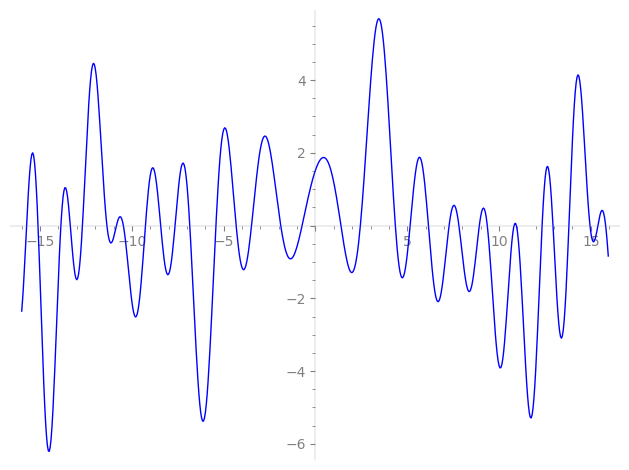| L(s) = 1 | + (−1 − i)2-s + 0.449i·3-s + 2i·4-s + (0.449 − 0.449i)6-s + (6.67 − 6.67i)7-s + (2 − 2i)8-s + 8.79·9-s + (−10.0 − 10.0i)11-s − 0.898·12-s + 13·13-s − 13.3·14-s − 4·16-s − 11.6·17-s + (−8.79 − 8.79i)18-s + (−6 + 6i)19-s + ⋯ |
| L(s) = 1 | + (−0.5 − 0.5i)2-s + 0.149i·3-s + 0.5i·4-s + (0.0749 − 0.0749i)6-s + (0.953 − 0.953i)7-s + (0.250 − 0.250i)8-s + 0.977·9-s + (−0.911 − 0.911i)11-s − 0.0749·12-s + 13-s − 0.953·14-s − 0.250·16-s − 0.688·17-s + (−0.488 − 0.488i)18-s + (−0.315 + 0.315i)19-s + ⋯ |
\[\begin{aligned}\Lambda(s)=\mathstrut & 650 ^{s/2} \, \Gamma_{\C}(s) \, L(s)\cr =\mathstrut & (-0.0277 + 0.999i)\, \overline{\Lambda}(3-s) \end{aligned}\]
\[\begin{aligned}\Lambda(s)=\mathstrut & 650 ^{s/2} \, \Gamma_{\C}(s+1) \, L(s)\cr =\mathstrut & (-0.0277 + 0.999i)\, \overline{\Lambda}(1-s) \end{aligned}\]
Particular Values
| \(L(\frac{3}{2})\) |
\(\approx\) |
\(1.525025071\) |
| \(L(\frac12)\) |
\(\approx\) |
\(1.525025071\) |
| \(L(2)\) |
|
not available |
| \(L(1)\) |
|
not available |
\(L(s) = \displaystyle \prod_{p} F_p(p^{-s})^{-1} \)
| $p$ | $F_p(T)$ |
|---|
| bad | 2 | \( 1 + (1 + i)T \) |
| 5 | \( 1 \) |
| 13 | \( 1 - 13T \) |
| good | 3 | \( 1 - 0.449iT - 9T^{2} \) |
| 7 | \( 1 + (-6.67 + 6.67i)T - 49iT^{2} \) |
| 11 | \( 1 + (10.0 + 10.0i)T + 121iT^{2} \) |
| 17 | \( 1 + 11.6T + 289T^{2} \) |
| 19 | \( 1 + (6 - 6i)T - 361iT^{2} \) |
| 23 | \( 1 - 33.3T + 529T^{2} \) |
| 29 | \( 1 + 48.3T + 841T^{2} \) |
| 31 | \( 1 + (-11.3 + 11.3i)T - 961iT^{2} \) |
| 37 | \( 1 + (31.6 - 31.6i)T - 1.36e3iT^{2} \) |
| 41 | \( 1 + (-45.3 + 45.3i)T - 1.68e3iT^{2} \) |
| 43 | \( 1 - 15.9T + 1.84e3T^{2} \) |
| 47 | \( 1 + (-59.4 + 59.4i)T - 2.20e3iT^{2} \) |
| 53 | \( 1 + 79.6iT - 2.80e3T^{2} \) |
| 59 | \( 1 + (53.4 + 53.4i)T + 3.48e3iT^{2} \) |
| 61 | \( 1 + 69.0T + 3.72e3T^{2} \) |
| 67 | \( 1 + (-58.7 - 58.7i)T + 4.48e3iT^{2} \) |
| 71 | \( 1 + (44.7 - 44.7i)T - 5.04e3iT^{2} \) |
| 73 | \( 1 + (-67.7 + 67.7i)T - 5.32e3iT^{2} \) |
| 79 | \( 1 - 74.7T + 6.24e3T^{2} \) |
| 83 | \( 1 + (-5.41 - 5.41i)T + 6.88e3iT^{2} \) |
| 89 | \( 1 + (35.6 + 35.6i)T + 7.92e3iT^{2} \) |
| 97 | \( 1 + (61.3 + 61.3i)T + 9.40e3iT^{2} \) |
| show more | |
| show less | |
\(L(s) = \displaystyle\prod_p \ \prod_{j=1}^{2} (1 - \alpha_{j,p}\, p^{-s})^{-1}\)
Imaginary part of the first few zeros on the critical line
−10.46357387100546344881027119377, −9.261444021939980781292460732957, −8.431593128176849108325415470379, −7.64951685262845192862345405531, −6.84538033597799480299200491229, −5.42182577592978879724785581316, −4.31962325895068371636294695699, −3.48255051982399812458445132650, −1.89103383664320379668632683851, −0.72814288258402843999809142284,
1.38878928322988115976235505236, 2.44534624813439080510806869814, 4.35123709983302700715876781933, 5.15617924015385204166939833293, 6.15420136432246860445897393974, 7.27973989044219346570050027279, 7.81459280894043308488669264577, 8.925724189008207082498920707738, 9.359785318210104869227609348585, 10.81790349524117778842732044708

